PEPtBO workshops explain the birds and bees
Administrator | Jul 31, 2019 | Comments 0
Story and photos by Sharon Harrison
Prince Edward Point Bird Observatory volunteers and friends explained the birds and bees in a first summertime fundraising effort.
A full day of events, held among the wildflowers at Stanners Vineyard in Hillier on Saturday, began early with a nature hike with Tom Wheatley. Other hikes followed through the day, and included a birds and bees adventure with County naturalist Terry Sprague, and a nature stroll with Amy Bodman.
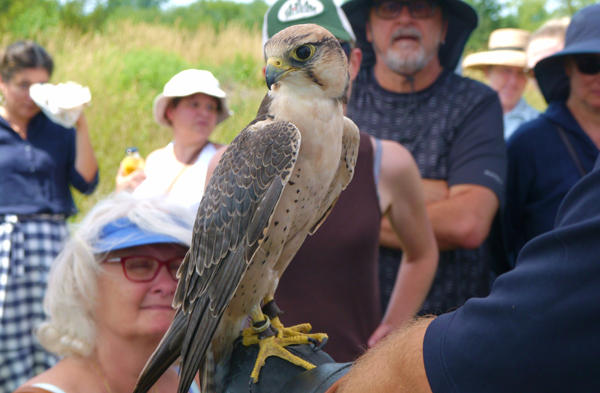
Matthew McFarland of Falcon Environmental Services introduced African falcon, ‘Africa’.
A raptor demonstration drew a large turnout with Matthew McFarland, of Falcon Environmental Services, and Africa, an eight or nine-year-old purebred African falcon, as well as Lorenzo or ‘Enzo’, a Harris hawk.
McFarland primarily works at airports and landfill sites, as well as attending educational events at schools and festivals.
“Africa is one of the birds we use on the airfield and her job is to draw away starlings, swallows and smaller birds,” said McFarland.
Winemaker Colin Stanners spoke about the straw bale construction of the tasting room, with information and advice on the benefits of building with straw.
While admission to the event was free of charge, to help with fundraising efforts, some of the walks and demonstrations charged a nominal fee of $10, and donations were gratefully accepted.
PEPtBO volunteer and board member John Hirsch said this first event of its kind for the organization and noted with its success, may be back next summer.
“We have our spring birding festival, we have the fall banding and our fall dinner, and saw-whet owl banding in October that attract people and help us raise funds,” he said. “This is an experiment and it seems to be working out pretty well.”
The Prince Edward Point Bird Observatory, a registered charity run by volunteers, is located on Long Point Road off County Road 13 in South Marysburgh, and is funded completely by donations. Hirsch noted that there is no government money involved.
“It does cost quite a bit to hire a professional bander and other expenses, so fundraising is a key thing that we do and that is what this event is all about.”
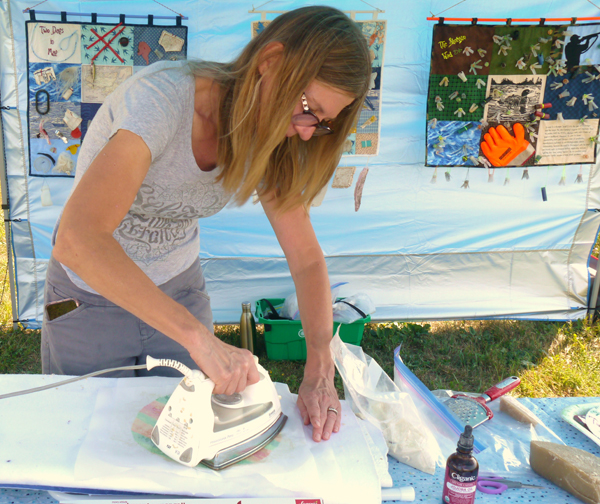
PEPtBO volunteer Hanne Simoes demonstrates how to make a beeswax wrap.
PEPtBO volunteer Hanne Simoes joyfully showed folks how to make a wax wrap during demonstrations throughout the day. The round pieces of fabric made of 100 per cent cotton, are sprinkled with grated beeswax, pine resin and jojoba oil, and fused together between sheets of parchment paper with a hot dry iron.
The beeswax wraps are an alternative cover to replace using plastic wrap. While not recommended for meat, she says the food-safe cotton wraps can be used over and over again, and can be washed in cool, soapy water.
Simoes had some beeswax wraps for sale, but also provided a detailed instruction sheet on how to make your own.
“I grate the beeswax with a grater just like if you were making a pizza, with a piece of parchment on the bottom, a little bit of pine resin just to give it that stickiness,” said Simoes, “and the jojoba oil makes it soft and pliable and come together.”
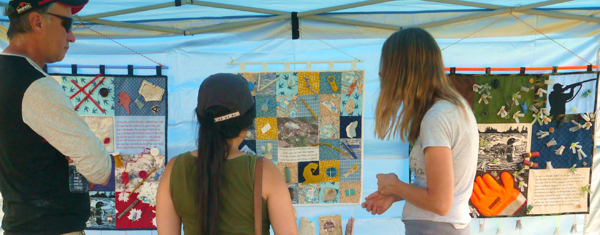
PEPtBO volunteer Hanne Simoes explains why she made several display quilts with found shoreline garbage.
Simoes also had some small hanging quilts on display depicting some of the garbage found around the County. One of the quilts was made up of just shotgun wads picked up off her shoreline property, which she said she found disturbing.
“I would like to get more quilts made for the Picton Fair, and I’d like to take them into schools,” she said. “The premise behind this one, ‘Two Days in May’ showcases the garbage I gathered where I live.”
“These quilts are being marred by the garbage, just as our lakes and rivers are being marred,” she said.
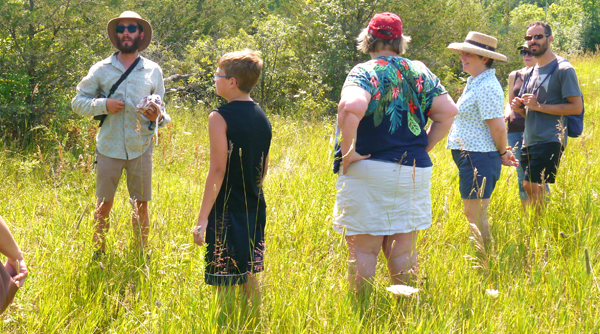
Matt Iles (centre) takes a group on a short walk to the three temporary bird banding nets.
The bird banding demonstrations also garnered significant interest as the Observatory’s Matt Iles set up three large nets on an adjacent field. While the heat of the day and the time of year were not conducive to catching birds, Iles and his audience were fortunate to have one bird fly into the net on the first of two demonstrations.
The robin was brought back to the bird banding table by Iles to be documented. He established it was a female bird, estimating the bird’s age, examining its feathers, and measuring its length. Before it was released, the bird received a tiny band on one of its legs which Iles applied with pliers, noting how the aluminum band is so light the bird would not notice its presence or be disturbed by it. Each banded bird has its own nine-digit number and no two birds have the same number.
He explained how the nets work and that they are made of very fine string, hand-knotted, and the idea is that the birds don’t see the nets as they fly from habitat to habitat.
“They just fly in and a number of them are just going to bounce out, but the smaller ones in particular will fly in and fall into this pocket and get a bit tangled up, so we will check the nets every 20-30 minutes.”
Iles noted that everyone checking the nets and taking the birds out of the nets is trained to a very high degree to ensure bird safety, which is paramount because the birds are delicate creatures.
“We would have a series of these nets down at the station, and we have 19 of them down at the point and we throw up extra ones for hawks and owls in the fall,” Iles said.
“The idea is that we are catching a sub-sample of what’s around on any given day and we mostly perform this work during the spring and the fall. You are mostly interested in how many young of the year there are, what condition are the young in, what condition are the parents in, and the main characteristics.”
He explained the work done at the Observatory is migration monitoring, noting some of the birds they are catching are coming from central and south America or the lower US.
“It gives us an opportunity to do some amazing research on the species. We are monitoring birds that are passing through southern Ontario on their migration, some of them will be stopping here to breed and others will be carrying on their journey quite far up north, and that can vary and can be as far as Algonquin or even up to the Boreal forest and beyond.”
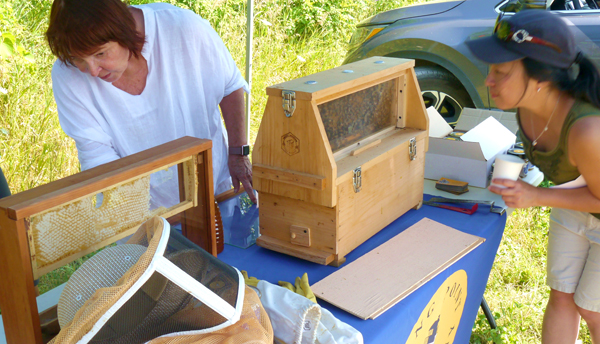
Julie White of Long Point Honey Company explains how honey is made.
Also among the day’s demonstrations were a honey demonstration with beekeeper Julie White from Long Point Honey Company, and a native plant workshop with Peter Fuller.
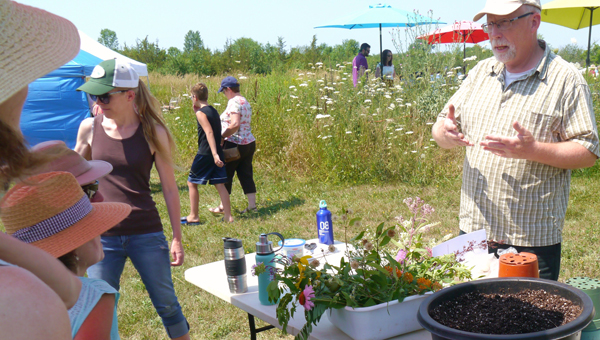
PEPtBO’s Peter Fuller begins the native plant workshop
“The idea of using native plants in your gardens and in landscaping as part of a sustaining and sustainable landscape is often what people are interested in,” said Fuller, who also spoke about pollinators and the importance of keeping a healthy garden community.
Children painted butterflies, made cork hummingbirds complete with a magnet to take home and created 3-D paper birds to fly. The table, run by PEPtBO volunteer Cheryl Chapman, also showed a number of local birds as part of the Naturehood program run by Nature Canada.
Chapman explained how the life-like preserved birds are freeze-dried and contain no moisture. The Naturehood program is taken into schools and educates children about different birds, their habitat, feeding and so on. As well, to differentiate between similar looking birds, they teach the children features such as tail and wing length, and feather patterns.
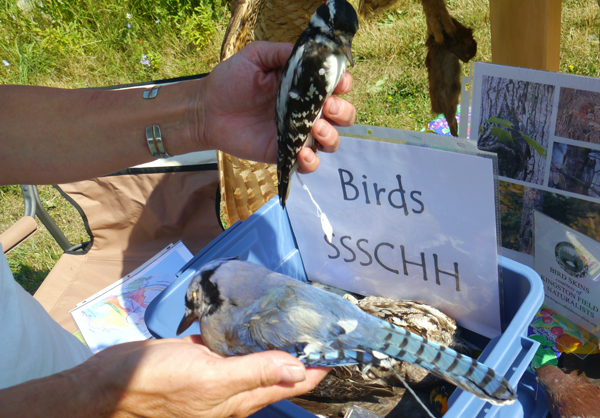
PEPtBO volunteer Cheryl Chapman shows a variety of freeze-dried birds used for educational purposes.
“We work with ‘SSSCHH’,” explained Chapman. “SSS stands for size, sound and shape. C is for colour and HH is for habitat and habit.”
Hirsch credits the day’s success to its two organizers, Kathy Felkar and Ketha Gillespie, who came up with the idea for the fundraiser.
“They are the ones who essentially put together the agenda and organized all the people and a lot of work went into that, so hats off to them,” he said.
Between 3,000- 4,000 birds are banded at the Observatory in the spring, and up to 5,000 each fall.
“We are aiming to put bands on the birds we catch in the hope that they get recovered, maybe caught at another station,” Iles said, noting there are about 20-30 of these stations across Canada.
“All the information collected can be compiled and sent to a continent-wide database, and you get a real sense of longevity; where birds are migrating to and from and their breeding habits,” he said.
Between Aug. 19 and Oct. 31, bird banding is being done at the observatory from dawn until noon, daily (not if raining, or too windy).
See a full schedule of Prince Edward Point Bird Observatory events in its Migration Matters publication, available to view, or download by clicking here: https://peptbo.ca/nature-matters.php
Filed Under: Arts & Culture • Featured Articles
About the Author:































